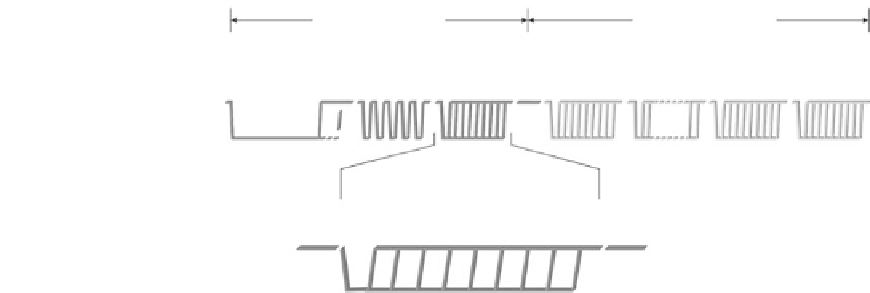Image Processing Reference
In-Depth Information
Message header
Message response
Synch break
≥ 13 bit
Synch field identifier
1-8 data bytes
Checksum
Byte-field
SCI/UART format
0
1234567
Start LSB
Stop
FIGURE .
Frame structure.
Signals are transported in the data field of a frame. Several signals can be packed into one frame as
long as they do not overlap each other. Each signal has exactly one producer, i.e., it is always written
bythesamenodeinthecluster.Zero,one,ormultiplenodesmaysubscribetothesignal.Akey
property of the LIN protocol is the use of schedule tables. Schedule table makes it possible to assure
that the bus will never be overloaded. hey are also the key component to guarantee timely delivery
of signals to the subscribing applications. Deterministic behavior is made possible by the fact that
all transfers in a LIN cluster are initiated by the master task. It is the responsibility of the off-line
synthesis/scheduling tool to assure that all frames relevant in a certain mode of operation are given
enough time to be transferred.
17.7 Design Process and Workflow
Regardless of the protocol a network design process comprises of three major elements:
•
Requirement capturing (signal definitions and timing requirements)
•
Network configuration/design
•
Network verification
The holistic concept of LIN supports the entire development, configuration, and validation of a
network by providing definition of all necessary interfaces.
The LIN workflow allows for the implementation of a seamless chain of design and development
tools enhancing speed of development and the reliability of the resulting LIN cluster.
The LIN configuration language allows description of a complete LIN network and also contains all
information necessary to monitor the network. his information is sufficient to make a limited emu-
lation of one or multiple nodes if it/they are not available. he LIN description file (LDF) can be one
component used to generate software for an ECU which shall be part of the LIN network. he LDF is
typically also used for verification, rest-bus simulation and as a configuration item (i.e., description
of the LIN communication in a CM system). An API has been defined by the LIN Standard, to pro-
vide a uniform, abstract way to access the LIN network from applications. he syntax of an LDF is
simpleandcompactenoughtobehandledmanually,butuseofcomputer-basedtoolsisencouraged.
Node capability files (NCF), as described in LIN Node Capability Language Specification, provides
one way to (almost) automatically generate LDFs.








